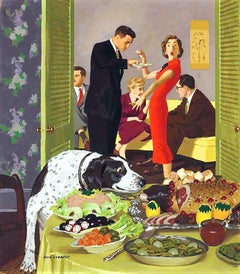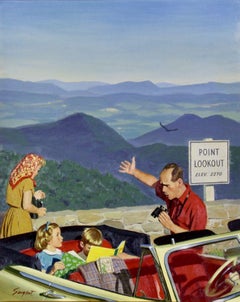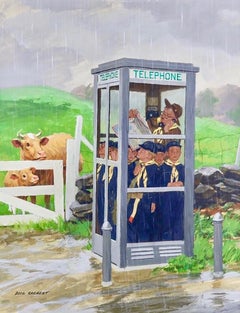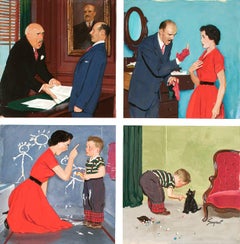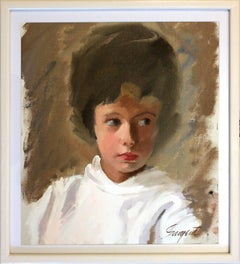Richard Sargent Paintings
American, 1911-1978
Richard 'Dick' Sargent, one of The Saturday Evening Post’s most prolific illustrators, was a Midwesterner born in Moline, Illinois, on March 26, 1911. His early career in art began just after his graduation from Moline High School when he went to work for a local printing and engraving plant. While there, Sargent attended night classes at the Moline Illinois Art School, the foundation for his future career as an artist. Sargent then studied at the Corcoran School of Art, and in 1951, he completed his first cover for The Saturday Evening Post, “Truth About Santa,” for the December 15 Christmas issue. While Sargent’s popularity grew through the exposure he received with the Post, he also did illustration work for magazines such as Fortune, Woman’s Day, Photoplay, and American Magazine among others. Americans adored Sargent and his art for his ability to show relatable, pregnant scenes with open-ended conclusions that commented on the situational comedy of life. In the late 1960s he retired to the Andalusia region of Spain and died there in 1978.(Biography provided by Lilac Gallery Ltd.)
to
12
9
9
3
3
5
4
Overall Height
to
Overall Width
to
1
11
7
4
4
4
3
3
2
2
2
1
1
1
1
1
1
1
1
1
1
12
10
1
15
930
650
639
610
12
9
8
8
4
Artist: Richard Sargent
Doggy Buffet, Saturday Evening Post Cover
By Richard Sargent
Located in Fort Washington, PA
Approximate Date: 1957
Medium: Oil and Pencil on Board
Signature: Signed Lower Left
Sight Size 23.50" x 20.75", Framed 29.50" x 26.50"
Original cover illustration for The Saturday E...
Category
1950s Richard Sargent Paintings
Materials
Board, Color Pencil, Oil
Suit Fitting, Post Cereal Advertisement
By Richard Sargent
Located in Fort Washington, PA
Signed Upper Left by Artist
Category
1950s Richard Sargent Paintings
Materials
Gouache
Lookout Point, Saturday Evening Post Cover
By Richard Sargent
Located in Fort Washington, PA
Medium: Oil on Canvas
Signature: Signed Lower Right
Original cover illustration for The Saturday Evening Post, July 18, 1953.
The Post described, “Gently, gently now, for both side...
Category
1950s Richard Sargent Paintings
Materials
Canvas, Oil
Cub Scouts in Phone Booth
By Richard Sargent
Located in Fort Washington, PA
Medium: Gouache and Pencil on Paperboard
Signature: Signed Lower Left
Original cover illustration for The Saturday Evening Post, August 26, 1961.
The Post described, “The Post desc...
Category
1960s Richard Sargent Paintings
Materials
Gouache, Paper, Board, Pencil
Modeling Dress, Cereal Advertisement
By Richard Sargent
Located in Fort Washington, PA
Medium: Oil on Board
Signature: Signed Lower Left
Category
1950s Richard Sargent Paintings
Materials
Oil, Board
Violin Practice, Saturday Evening Post Cover
By Richard Sargent
Located in Fort Washington, PA
Date: 1955
Medium: Gouache on Board
Dimensions: 24.00" x 18.50"
Signature: Signed Lower Right
Original cover illustration for The Saturday Evening Post, February 5, 1955.
The Post ...
Category
1950s Richard Sargent Paintings
Materials
Gouache, Board
Boy Blowing his Trumpet at a Birthday Dinner
By Richard Sargent
Located in Fort Washington, PA
Medium: Tempera on Board
Signature: Signed Lower Left
Submitted as a Saturday Evening Post Cover
Category
1950s Richard Sargent Paintings
Materials
Tempera, Board
Shade Tree
By Richard Sargent
Located in Fort Washington, PA
Medium: Gouache, Tempera and Pencil on Paperboard
Signature: Signed 'Dick Sargent' (Lower Left)
Sight Size 23.00" x 21.88", Framed 29.00" x 28.00"
Cover of the April 12th, 1958 issu...
Category
1950s Richard Sargent Paintings
Materials
Pencil, Tempera, Board, Gouache
"Her" American 20th century oil painting Portrait of a Woman from the 1950's
By Richard Sargent
Located in New York, NY
A wonderful portrait of a woman from the 1950's with beautiful blonde hair wearing a white colored shirt. The impressionistic style is very attractive with fast brushwork and dashing...
Category
20th Century American Impressionist Richard Sargent Paintings
Materials
Paper, Gouache
American Original Illustration for Woman's Day Magazine January 1952
By Richard Sargent
Located in New York, NY
This piece was completed and published on the cover of "Woman's Day" magazine January 1952. A little boy eats a chocholate bar in the back seat of a car from the times. A glimpse of...
Category
1950s American Realist Richard Sargent Paintings
Materials
Gouache, Cardboard
1950s American Original Illustration of Little Girl Window Shopping in Toy Store
By Richard Sargent
Located in New York, NY
This piece was completed in the 1950's by famous American Artist Richard Sargent. A colorful and vibrant depiction of a little girl with wide happy eyes in love with a standing doll in a toy store window. Other toys are depicted in the window; a typical scene that captures the essance of a little girl from this time. This piece is signed on verso reading "C35 Painted by Dick Sargent" and underneath signed in script Richard Thomas Sargent...
Category
1950s American Realist Richard Sargent Paintings
Materials
Gouache, Cardboard, Pencil
1950s Original Illustration of Man at Breakfast Table "Post" Advertisement
By Richard Sargent
Located in New York, NY
This piece was completed and published in "This Week Magazine" May 4, 1958 for an advetisment with "Post." The slogan reads in the magazine above the illustration:
"Any Cereal my family leaves is first choise with me...as long as it's in Post-Tens"
A vibrant depiction of a man from the 1950's with a bright yellow back ground seated...
Category
1950s American Realist Richard Sargent Paintings
Materials
Gouache, Cardboard
Related Items
Evening prayers by fishermen under the high coast of Celebes
Located in Amsterdam, NL
Jacob Eduard Van Heemskerck Van Beest (1828-1894)
“Avondgebed; Maleidische tripang visschers onder de hoge kust van Celebes” (Ev...
Category
19th Century Romantic Richard Sargent Paintings
Materials
Canvas, Oil
Free Shipping
H 26.38 in W 42.13 in D 1.58 in
The Abduction of the Sabine Women , a Renaissance drawing by Biagio Pupini
Located in PARIS, FR
This vigorous drawing has long been attributed to Polidoro da Caravaggio: The Abduction of the Sabine Women is one of the scenes that Polidoro depicted between 1525 and 1527 on the façade of the Milesi Palazzo in Rome. However, the proximity to another drawing inspired by this same façade, kept at the Ecole des Beaux-Arts, and to other drawings inspired by Polidoro kept at the Musée du Louvre, leads us to propose an attribution to Biagio Pupini, a Bolognese artist whose life remains barely known, despite the abundant number of drawings attributed to him.
1. Biagio Pupini, a Bolognese artist in the light of the Roman Renaissance
The early life of Biagio Pupini, an important figure of the first half of the Cinquecento in Bologna - Vasari mentions him several times - is still poorly known. Neither his date of birth (probably around 1490-1495) nor his training are known. He is said to have been a pupil of Francesco Francia (1450 - 1517) and his name appears for the first time in 1511 in a contract with the painter Bagnacavallo (c. 1484 - 1542) for the frescoes of a church in Faenza. He then collaborated with Girolamo da Carpi, at San Michele in Bosco and at the villa of Belriguardo.
He must have gone to Rome for the first time with Bagnacavallo between 1511 and 1519. There he discovered the art of Raphael, with whom he might have worked, and that of Polidoro da Caravaggio. This first visit, and those that followed, were the occasion for an intense study of ancient and modern art, as illustrated by his abundant graphic production.
Polidoro da Caravaggio had a particular influence on the technique adopted by Pupini. Executed on coloured paper, his drawings generally combine pen, brown ink and wash with abundant highlights of white gouache, as in the drawing presented here.
2. The Abduction of the Sabine Women
Our drawing is an adaptation of a fresco painted between 1525 and 1527 by Polidoro da Caravaggio on the façade of the Milesi Palace in Rome. These painted façades were very famous from the moment they were painted and inspired many artists during their stay in Rome. These frescoes are now very deteriorated and difficult to see, as the palace is in a rather narrow street.
The episode of the abduction of the Sabine women (which appears in the centre of the photo above) is a historical theme that goes back to the origins of Rome and is recounted both by Titus Livius (Ab Urbe condita I,13), by Ovid (Fasti III, 199-228) and by Plutarch (II, Romulus 14-19). After killing his twin brother Romus, Romulus populates the city of Rome by opening it up to refugees and brigands and finds himself with an excess of men. Because of their reputation, none of the inhabitants of the neighbouring cities want to give them their daughters in marriage. The Romans then decide to invite their Sabine neighbours to a great feast during which they slaughter the Sabines and kidnap their daughters.
The engraving made by Giovanni Battista Gallestruzzi (1618 - 1677) around 1656-1658 gives us a good understanding of the Polidoro fresco, allowing us to see how Biagio Pupini reworked the scene to extract this dynamic group.
With a remarkable economy of means, Biagio Pupini takes over the left-hand side of the fresco and depicts in a very dense space two main groups, each consisting of a Roman and a Sabine, completed by a group of three soldiers in the background (which seems to differ quite significantly from Polidoro's composition).
The balance of the drawing is based on a very strongly structured composition. The drawing is organised around a median vertical axis, which runs along both the elbow of the kidnapped Sabine on the left and the foot of her captor, and the two main diagonals, reinforced by four secondary diagonals. This diamond-shaped structure creates an extremely dynamic space, in which centripetal movements (the legs of the Sabine on the right, the arm of the soldier on the back at the top right) and centrifugal movements (the arm of the kidnapper on the left and the legs of the Sabine he is carrying away, the arm of the Sabine on the right) oppose each other, giving the drawing the appearance of a whirlpool around a central point of support situated slightly to the left of the navel of the kidnapper on the right.
3. Polidoro da Caravaggio, and the decorations of Roman palaces
Polidoro da Caravaggio was a paradoxical artist who entered Raphael's (1483 - 1520) workshop at a very young age, when he oversaw the Lodges in the Vatican. Most of his Roman work, which was the peak of his career, has disappeared, as he specialised in facade painting, and yet these paintings, which are eminently visible in urban spaces, have influenced generations of artists who copied them abundantly during their visits to Rome.
Polidoro Caldara was born in Caravaggio around 1495-1500 (the birthplace of Michelangelo Merisi, known as Caravaggio, who was born there in 1571), some forty kilometres east of Milan. According to Vasari, he arrived as a mason on the Vatican's construction site and joined Raphael's workshop around 1517 (at the age of eighteen according to Vasari). This integration would have allowed Polidoro to work not only on the frescoes of the Lodges, but also on some of the frescoes of the Chambers, as well as on the flat of Cardinal Bibiena in the Vatican.
After Raphael's death in 1520, Polidoro worked first with Perin del Vaga before joining forces with Maturino of Florence (1490 - 1528), whom he had also known in Raphael's workshop. Together they specialised in the painting of palace façades. They were to produce some forty façades decorated with grisaille paintings imitating antique bas-reliefs.
The Sack of Rome in 1527, during which his friend Maturino was killed, led Polidoro to flee first to Naples (where he had already stayed in 1523), then to Messina. It was while he was preparing his return to the peninsula that he was murdered by one of his assistants, Tonno Calabrese, in 1543.
In his Vite, Vasari celebrated Polidoro as the greatest façade decorator of his time, noting that "there is no flat, palace, garden or villa in Rome that does not contain a work by Polidoro". Polidoro's facade decorations, most of which have disappeared as they were displayed in the open air, constitute the most important lost chapter of Roman art of the Cinquecento. The few surviving drawings of the painter can, however, give an idea of the original appearance of his murals and show that he was an artist of remarkable and highly original genius.
4. The façade of the Milesi Palace
Giovanni Antonio Milesi, who commissioned this palace, located not far from the Tiber, north of Piazza Navona, was a native of the Bergamo area, like Polidoro, with whom he maintained close friendly ties. Executed in the last years before the Sack of Rome, around 1526-1527, the decoration of Palazzo Milesi is considered Polidoro's greatest decorative success.
An engraving by Ernesto Maccari made at the end of the nineteenth century allows us to understand the general balance of this façade, which was still well preserved at the time. The frescoes were not entirely monochrome, but alternated elements in chiaroscuro simulating marble bas-reliefs and those in ochre simulating bronze and gold vases...
Category
16th Century Old Masters Richard Sargent Paintings
Materials
Ink, Gouache, Pen
Chess Players WPA Depression Era Mid-20th Century American Scene Realism Modern
By Mervin Jules
Located in New York, NY
Chess Players WPA Depression Era Mid-20th Century American Scene Realism Modern. Signed upper right and verso 8 x 10 inches oil on board.
BIO
The son of a men's haberdasher, Mervin ...
Category
1930s American Realist Richard Sargent Paintings
Materials
Oil, Board
A. J. Bennett - Light and Shade - Post Impressionist Painting, South Africa 1919
Located in Meinisberg, CH
A. J. Bennett
(South African, fl. Early 20th century)
Light and Shade
• Oil on canvas artist board ca. 42.5 x 29.5 cm
• Later frame ca. 53.5 x 41 cm
Worldwide shipping is complime...
Category
1910s Post-Impressionist Richard Sargent Paintings
Materials
Canvas, Oil, Board
Free Shipping
H 21.07 in W 16.15 in D 0.79 in
Fenêtre sur lac, Original Painting, Still-Life, Interior Scene, Ready to hang
Located in AIX-EN-PROVENCE, FR
Oil painting and Oil based color pencils on Archival Cardboard 2mm - Original Painting and Drawing, Still-Life, Interior, Ready to hang
Work Title : Fenêtre sur lac (EN : Window on lake)
Artist : Gabriel Riesnert...
Category
21st Century and Contemporary Contemporary Richard Sargent Paintings
Materials
Cardboard, Oil, Oil Crayon
H 7.88 in W 10.24 in D 0.4 in
Freya (Seated Backwards), Mixed media on grey board
By Howard Tangye
Located in London, GB
Howard Tangye (b.1948, Australia) has been an influential force in fashion for decades. Lecturing at London’s Central Saint Martins for 35 years, including 16 years as head of BA Wom...
Category
2010s Contemporary Richard Sargent Paintings
Materials
Other Medium, Archival Paper, Handmade Paper, Pen, Felt Pen, Permanent M...
Botanical Still Life Green Floral Impressionist Painting - Fall in Emerald Green
By Kellie Newsome
Located in Los Angeles, CA
Georgia-based artist Kellie Newsome specializes in dynamic and abstracted still-life artworks. Her expressive style emphasizes line structure, creating vibrant paintings that celebra...
Category
2010s Contemporary Richard Sargent Paintings
Materials
Canvas, Mixed Media, Acrylic, Color Pencil
Summer Fashion. Young Victorian Lady With Meadow Flowers In Her Straw Hat
Located in Sutton Poyntz, Dorset
Alice Anne Renshaw.
English ( b.1849 - d.1900 ).
Young Lady With Meadow Flowers In Her Straw Hat
Watercolor & Gouache on Artist's Board ( An embossed stamp in the top left hand corn...
Category
Late 19th Century Realist Richard Sargent Paintings
Materials
Watercolor, Gouache, Board
H 29.93 in W 25.6 in D 2.96 in
"Les Rois de Legendes #24 Musicien" The Kings Of Legend #24 Musician
Located in Berlin, MD
Erte (Romain de Tirtoff) Russian/French 1892-1990. "Les Rois de Legendes #24 Musicien" The Kings Of Legend #24 Musician. A beautiful, original gouache and ink piece (this is not a ...
Category
Early 20th Century Art Deco Richard Sargent Paintings
Materials
Ink, Gouache
Circle Jerks - Group Sex (Record Label, Ticket Stub, Setlists, Contemporary Pop)
By Kerry Smith
Located in Kansas City, MO
Kerry Smith
Circle Jerks - Group Sex
Mixed Media on Crescent board
Year: 2021
Size: 12x12in
Framed
Signed, dated by hand
COA provided
Ref.: 924802-1612
----...
Category
2010s Pop Art Richard Sargent Paintings
Materials
Mixed Media, Acrylic, Gouache, Board
Figure in a Lanscape
By Francis Plummer
Located in London, GB
Oil on board, 62cm x 42cm, (70cm x 50cm framed). The picture is in good condition.
Plummer trained at the Royal Academy Schools in the early 1950s, championed by Stanley Spencer and Sir Herbert Read, he was the recipient of the coveted Leverhulme Scholarship. In a mixed career which included illustration work for The National Trust, anatomical illustration for Guys Hospital and teaching, painting ran parallel to his commercial work. Plummer specialised in the medium of egg tempera, as well as oil painting, a technique little used since the frescos of the Renaissance, he often worked on a large scale, but in tremendous detail, combining Classical iconography and formal composition with visual exploration evocative of William Blake and...
Category
1980s Post-War Richard Sargent Paintings
Materials
Oil, Board
"Tailor" WPA American Scene Social Realism Modernism Mid Century Modern Fashion
By Mervin Jules
Located in New York, NY
"Tailor" WPA American Scene Social Realism Modernism Mid Century Modern Fashion
The board measures 9 1/2 x 15 1/2.
Provenance: Mervin Jules Estate.
Bio
A painter, illustrator, pri...
Category
1930s American Modern Richard Sargent Paintings
Materials
Oil, Board
Previously Available Items
"Anger Transference" Saturday Evening Post Cover
By Richard Sargent
Located in Fort Washington, PA
Date: 1954
Medium: Gouache on Board
Dimensions: 21.25" x 20.75"
Signature: Signed Lower Right
Saturday Evening Post cover, March 20, 1954
"Dick Sargent a gifted portr...
Category
1950s Richard Sargent Paintings
Materials
Gouache, Board
American 20th Century Oil Painting Portrait of Woman from 1950's
By Richard Sargent
Located in New York, NY
A wonderful portrait of a woman from the 1950's with a Bea Hive hair due dressed in a white dress. The impressionistic style is very attractive with fast brush work and dashing lines...
Category
20th Century American Impressionist Richard Sargent Paintings
Materials
Canvas, Oil
Richard Sargent paintings for sale on 1stDibs.
Find a wide variety of authentic Richard Sargent paintings available for sale on 1stDibs. If you’re browsing the collection of paintings to introduce a pop of color in a neutral corner of your living room or bedroom, you can find work that includes elements of green, pink, yellow and other colors. You can also browse by medium to find art by Richard Sargent in paint, board, gouache and more. Much of the original work by this artist or collective was created during the 20th century and is mostly associated with the Impressionist style. Not every interior allows for large Richard Sargent paintings, so small editions measuring 9 inches across are available. Customers who are interested in this artist might also find the work of Amos Sewell, Spencer Douglass Crockwell, and Robert Riggs. Richard Sargent paintings prices can differ depending upon medium, time period and other attributes. On 1stDibs, the price for these items starts at $3,000 and tops out at $159,000, while the average work can sell for $25,500.
